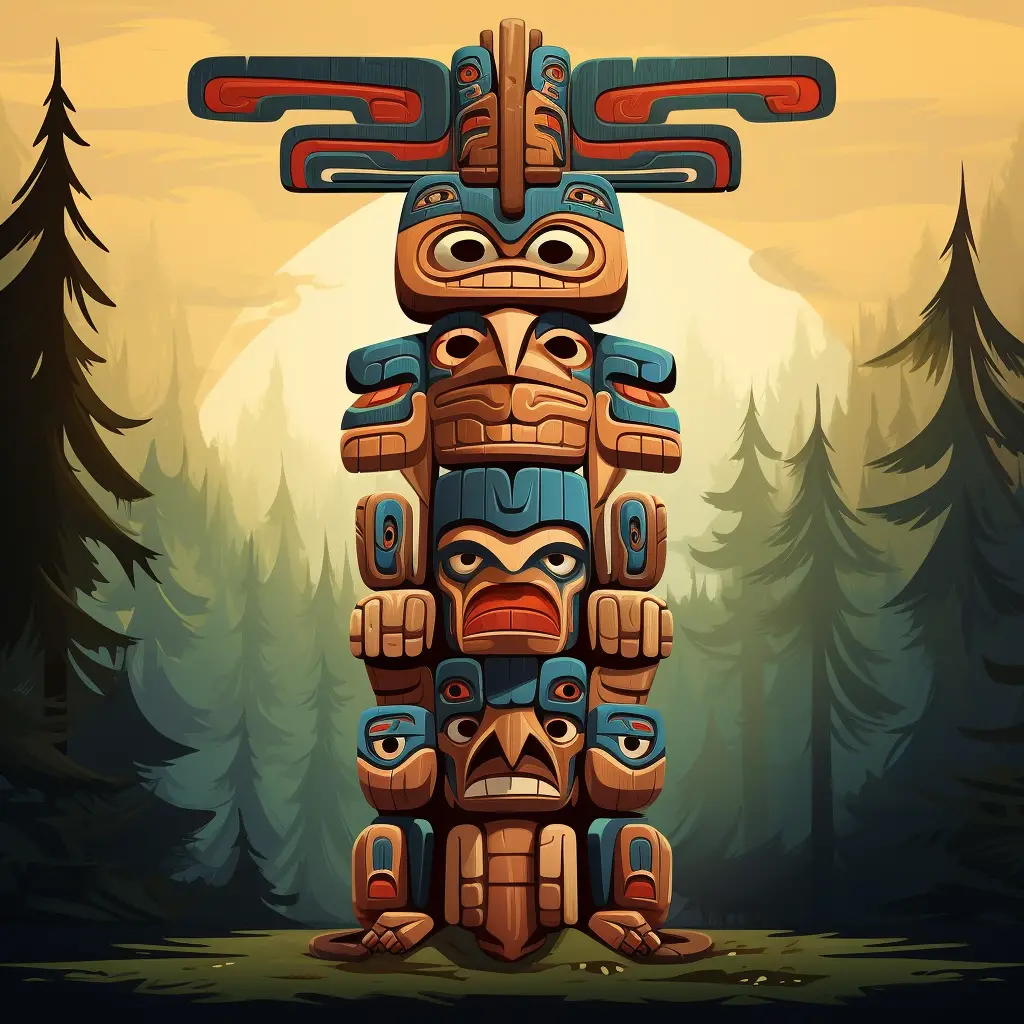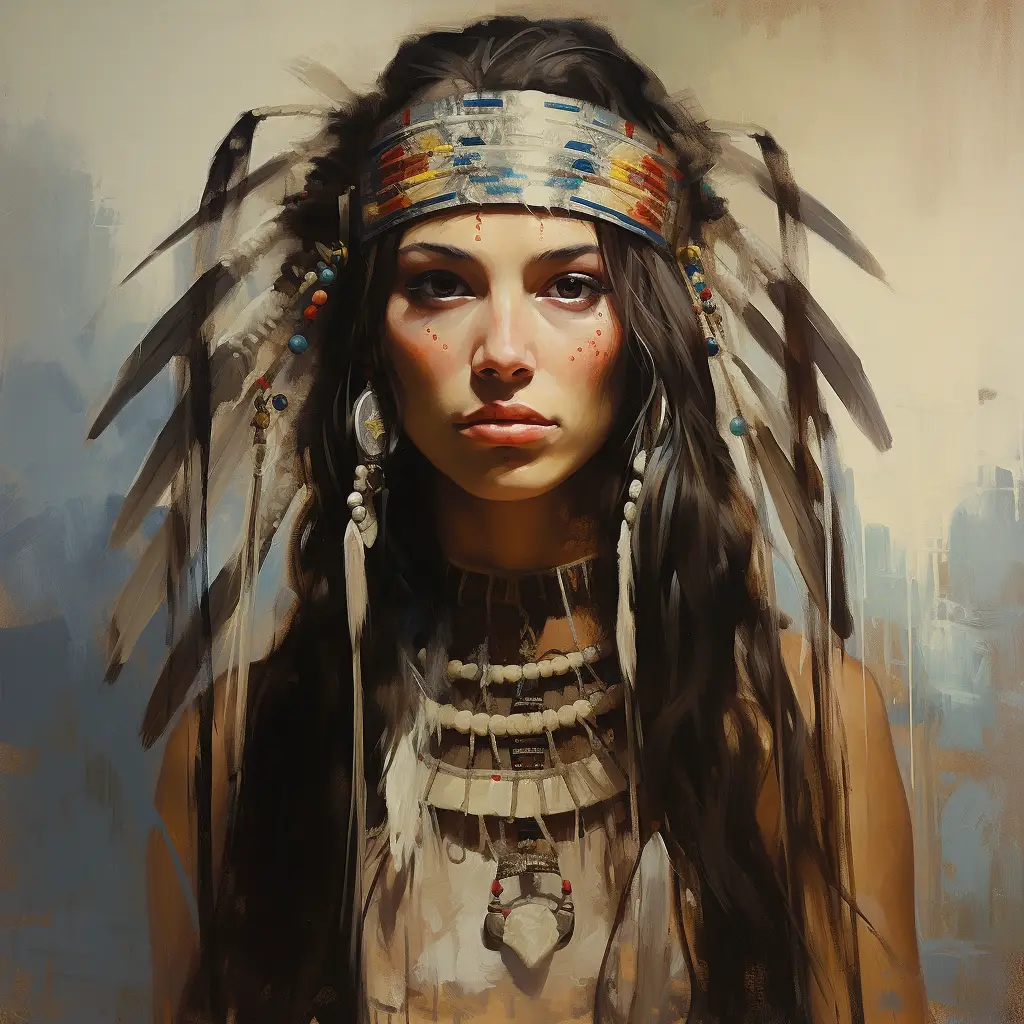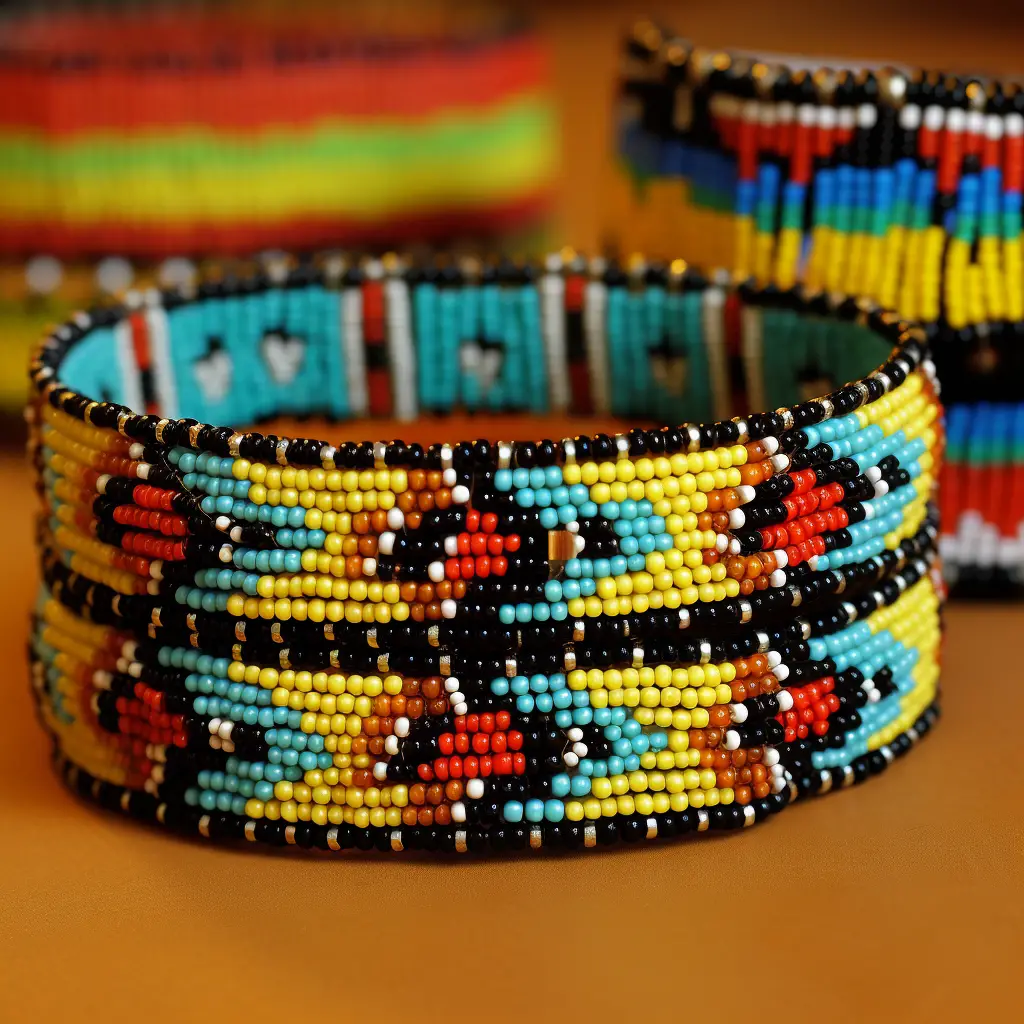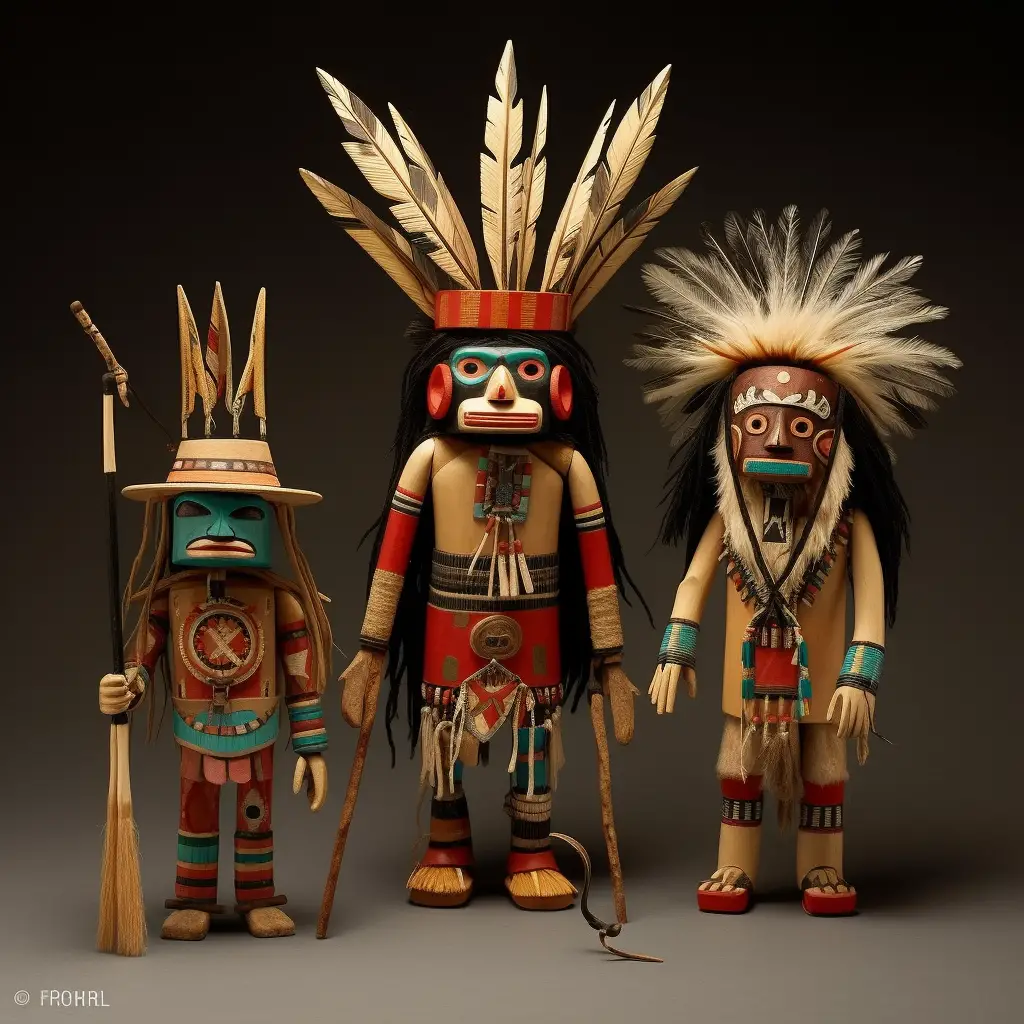Native American Art
There were many Native American tribes across North America. They each had their own unique culture. Many tribes developed unique art forms, as well. Since tribes were often very different from each other, their art was often very different from each other. Generally, only native societies that settled in an area for a long period of time pursued art. Tribes that moved often did not have time for creative pursuits.
Native American art encompasses a wide range of artistic expressions, including pottery, basketry, jewelry, and textiles. These art forms have deep cultural and spiritual significance, often reflecting the connection between Native American communities and the natural world.
Traditional techniques and materials are used to create intricate designs and patterns that tell stories and preserve cultural heritage. Native American art continues to evolve and thrive, with contemporary artists blending traditional elements with modern influences, creating vibrant and meaningful works of art.

Native American Art Facts For Kids
- Art includes carvings, pottery, and paintings.
- Totem poles told family stories.
- Beadwork was common in jewelry making.
- Basket weaving was a useful craft.
- Native art uses natural materials.
- Dream catchers were made as symbols.
- Clay pottery was often decorated.
- Each tribe’s art is unique.
- Feathers were used in many crafts.
Art Forms
Native American Art is rich and diverse, spanning thousands of years. It encompasses various art forms such as pottery, painting, jewelry making, totem pole carving, and basket weaving. Each tribe has its own unique artistic style and techniques. Materials used are typically sourced from nature, like clay, wood, feathers, and beads. An integral part of their culture, the art often narrates the tribe’s stories, beliefs, and dreams. From intricate beadwork to symbolic dream catchers, Native American art is a vibrant testament to their heritage.
Art Designs
Native American Art is a blend of creativity and tradition, characterized by unique designs. Each tribe expresses its history and spirituality through art, resulting in diverse motifs and symbols. Patterns often reflect elements of nature or tribal mythology. Both abstract and geometric designs can be found in their beadwork, pottery, textiles, and carvings. The artistic designs were not merely ornamental; they served a deeper purpose of storytelling and identity expression. These designs remain a critical part of Native American heritage and continue to inspire modern art.
American Indian Art
Native American Art, also known as American Indian Art, is a wide-ranging field with deep roots in history and culture. It includes diverse forms like pottery, weaving, beading, paintings, and carvings. Each tribe has distinct artistic practices that echo their cultural narratives and spiritual beliefs. Valued for their craftsmanship, these art pieces reflect the tribes’ connection with nature, using materials like clay, wood, feathers, and stones. From intricate totem poles to colorful blankets, American Indian art significantly contributes to the rich tapestry of global art.
Ceremonial Art
Native American Art holds significant importance in tribal ceremonies. Ceremonial art often serves a functional and symbolic purpose, playing a crucial role in rituals, celebrations, and rites. This includes beautifully crafted masks, ritualistic pottery, intricate beadwork, and vibrant feathered headdresses. Totem poles and kachina dolls often carry spiritual significance. Each object tells a story or portrays spiritual beings, illustrating the tribe’s beliefs and traditions. The creation of ceremonial art involves specific rituals and is retained as a cherished part of Native American heritage.
Pueblo Art
Pueblo art is a crucial part of Native American Art, originating from Pueblo tribes in New Mexico and Arizona. Renowned for their pottery, the Pueblo people create beautifully adorned vessels using techniques passed down through generations. Designs often depict nature, spiritual concepts, or geometric patterns. Besides pottery, they also excel in creating murals, Kachina dolls, and woven textiles. These artworks encapsulate the Pueblo way of life, their spiritual beliefs, and reverence for the natural world, making Pueblo art a vibrant facet of Native American Art.
Art Elements

Native American Art masterfully utilizes fundamental art elements to convey meaning and stories. The use of line in patterns and imagery, both organic and geometric, is common in textile designs and pottery. The forms of art like totem poles and ceramics give depth to their work, while color is often used symbolically, with certain shades representing specific tribal elements or spiritual concepts. The choice of materials adds texture and defines the artwork’s quality, such as the softness of a woven blanket or the roughness of a carved figure. These elements together form a powerful expression of tribal culture and spirituality.
Related Visual Art Expressions
Native American Art provides a foundation for many related visual art expressions in contemporary artistry worldwide. Their traditional elements, symbols, and methods inspire modern painters, sculptors, and textile artists. The powerful symbolism, vibrant colors, and geometric patterns found in Native American pieces have significantly influenced abstract and surrealistic art forms. Moreover, Native American motifs are often seen in graphic design and fashion. Public art installations and murals also pay homage to these indigenous art forms, keeping the rich, artistic legacy of Native American tribes alive and appreciated.
Early Southwestern Art
Native American Art in the early southwestern region is renowned for its diversity and sophistication. The tribes, including Hopi, Zuni, and Navajo, excelled in creating intricate pottery, textiles, and sand paintings. The Pueblo people are particularly known for their murals, which adorn ancient architectural structures. Their art often incorporates elements of nature and spiritual concepts using vivid colors and symbols. Turquoise jewelry and woven baskets also feature prominently in early southwestern Native American Art, underpinning their deep connection to the land and its resources.
American Indian Artists
American Indian artists play a crucial role in the creation and evolution of Native American Art. Though steeped in tradition, these artists often bring their individual perspectives and innovation to the artwork. From skilled pottery masters and accomplished weavers to contemporary painters and sculptors, they imbue their creations with cultural significance and personal narratives. Artists like R.C. Gorman, Allan Houser, and Maria Martinez are acclaimed for their work in elevating Native American Art. Their creations continue to engage audiences, preserve cultural heritage, and inspire future generations.
Individual Artists
Individual artists have had a profound impact on Native American Art. Artists like Fritz Scholder revolutionized the portrayal of Native American life in contemporary paintings. The renowned potter Maria Martinez is known for her striking black-on-black pottery technique. Jaune Quick-To-See Smith, a modern abstract artist, explores social and political issues through her work. Each artist brings a unique perspective, often meshing traditional indigenous techniques with contemporary artistic practices. These individual artists keep the spirit of Native American Art alive while exploring new dimensions and narratives.
Totem Poles
Totem poles, a crucial component of Native American art, are particularly prominent in the indigenous cultures of the Pacific Northwest, such as the Haida, Tlingit, and Tsimshian. These monumental sculptures, usually carved from the Western Red Cedar abundant in the area, are not religious objects as commonly believed.
Instead, they function as crucial depictions of family lineage and cultural heritage, narrating familial legends, clan lineages, or significant events through symbolic animal and human forms, each embodying different attributes, traits, or powers.
The detailed and colorful designs demonstrate the significant artistic skill and profound cultural understanding of the Native American artists. Far from being objects of worship, totem poles are respected symbols of ancestry and cultural beliefs.
Beadwork

Beadwork, a significant aspect of Native American art, carries a rich history and cultural value across various tribes, tracing its roots back to 8800 BCE when early pieces were crafted from bones, stones, and shells.
The arrival of Europeans introduced glass beads, which were swiftly incorporated into their artistry. Each tribe has its unique style and pattern of beadwork, with these intricate creations reflecting their distinct traditions and narratives. For example, the Iroquois are particularly renowned for their raised beadwork, while the Plains tribes are recognized for their elaborate floral and geometric patterns on hides.
More than just an art form, beadwork serves as an expression medium, a preservation tool for heritage, and a crucial element of Native American identity.
Pottery
Native American pottery, a deeply symbolic and rich art form, embodies storytelling, functionality, and ceremonial significance. The individuality of each tribe shines through their unique pottery-making styles and techniques, often influenced by their specific culture and environment.
For example, the Pueblo tribe of the American Southwest creates polished blackware pottery, whereas the Hopi tribe is celebrated for its intricate designs and symbols. The pottery-making process typically entails hand-building methods such as coiling and pinching instead of wheel usage.
Local clay is commonly used, and the pottery is fired in a pit dug into the ground, a method known as pit firing. Significantly, Native American pottery transcends being a mere physical art form, symbolizing the creators’ profound connection to their land, ancestry, and customs.
Navajo Weaving
Navajo weaving, an integral component of Native American artistry with origins dating back to the late 1600s, is a rich tradition passed down primarily through the women of the Navajo Nation. This painstaking and time-consuming process, which begins with wool shearing and ends with intricate weaving on a loom, results in clothing, blankets, and ceremonial artifacts embodying Navajo culture and spirituality.
The designs intricately woven into each piece often represent elements of Navajo belief systems, including the earth, sky, and life’s journey. Initially, the vibrant colors were derived from natural plant and mineral-based dyes, but the integration of synthetic dyes over time has expanded the color palette.
The intricate geometric patterns and vivid hues of the rugs and tapestries produced are revered as some of the finest examples of Native American art.
Kachina Dolls

Kachina Dolls, revered in Native American art, are especially prominent in the Southwestern United States’ Hopi and Pueblo cultures. More than decorative pieces, these intricately carved and painted figures serve as religious symbols that encapsulate the essence of Kachina, a significant deity in these communities.
The dolls, each representing a distinct Kachina, embody individual attributes and societal roles. The detailed designs on these figures mirror the spiritual traits and aspects of the represented Kachina.
Traditionally, men of the tribe carve these dolls from cottonwood root, serving as an educational tool to instruct children about their culture and the diverse Kachina spirits. Despite their global presence in museums and private collections, it’s critical to respect their sacred value within their native communities.
Wampum Belts
The profound historical and cultural roots of Native American art are deeply embodied in the significant aspect of Wampum belts, particularly among the Iroquois and other northeastern U.S tribes. Crafted meticulously from small tubular beads derived from the shells of specific clams—Wampum, these belts are more than an aesthetic masterpiece—they are tangible narrations of stories, historical agreements, treaties, and significant events.
The intricate patterns and symbols on each belt, coupled with the meaningful colors of the beads—white symbolizing peace and harmony, and purple signifying serious occasions or events—beautifully blend to create this form of art. Thus, Wampum belts serve as a testament to the rich heritage and storytelling traditions of Native American communities, merging aesthetic appeal with profound cultural significance.
Inuit Carvings
Inuit carvings are a crucial element of Native American art, bearing substantial cultural and historical importance. These works of art, typically fashioned from materials such as soapstone, bone, ivory, and antler, often portray animals, hunting scenarios, and spiritual beliefs of the Inuit people.
One distinctive aspect of Inuit carvings is the transformational art that embodies their belief in animism – the concept that every living and non-living entity possesses a spirit. This unique form of art depicts the metamorphosis of human figures into animals and vice versa, representing the profound interconnectedness of all life forms.
Inuit carvings, therefore, not only display the artistic prowess of the Inuit people but also offer a window into their age-old traditions and lifestyle.
Dreamcatchers
The Dreamcatcher, a significant symbol in Native American art, encapsulates a deep cultural narrative of spirituality and storytelling. Deriving from the Ojibwe (Chippewa) tribe, these iconic artifacts traditionally consisted of willow hoops and sinew, embellished with sacred elements such as feathers and beads.
The intricate web was considered to ensnare bad dreams, allowing only good ones to trickle down the feathers to the dreamer. This emblem serves not merely as a protective amulet in Native American culture but also epitomizes their bond with nature, spirituality, and the realm of dreams.
In contemporary times, Dreamcatchers persists as a vital component of Native American art, shedding light on the cultural richness and spiritual profundity of the indigenous tribes from which they originated.
Ledger Art
Originating in the mid-19th century Plains region, Ledger Art is a significant genre in Native American art history. It was primarily crafted by Native American men held as prisoners of war, using ledger books and lined paper introduced by European settlers, hence the term ‘Ledger Art’.
This art form was an extension of the pictographic art traditions of their ancestors who used buffalo hides to depict daily life scenes, record events, and tell stories. Ledger Art often illustrated warfare scenes, hunting, religious ceremonies, and occasional interactions with white settlers.
Serving both as a historical record and a form of expression, this style of art marked a time of significant cultural transition and challenges for Native Americans.
Pictographs
Pictographs, integral to Native American Art, are more than mere drawings; they are complex symbols painted on rock surfaces using natural substances like plant extracts, clay, and charcoal.
These symbolic representations, which convey narratives, rituals, or occurrences, embody profound cultural and spiritual implications, signifying their role as a refined form of communication. The most ancient pictographs, believed to be over 5,000 years old and located in the Great Basin region of the United States, attest to the enduring legacy of Native American art traditions.
These pictographic records offer a captivating insight into the lives, convictions, and customs of North America’s indigenous inhabitants.
The Artistry and Significance of Native American Pottery
One of the most common types of art created by Native Americans was pottery. Not all tribes made pottery. The Lakota Sioux, for example, moved too often to carry around heavy pieces of pottery. Most tribes, however, made pottery for its usefulness and also because it was beautiful.
Native Americans often made pottery the same way that artists make it today. They used a spinning wheel, or they sometimes made coil and pinch pots. Many pottery pieces were decorated with important symbols, such as animals. Sometimes native pottery recorded important events in the history of a tribe.
In addition to pottery, Native Americans also made colorful and beautiful baskets. Basket weaving was a common pastime for native women, who spent long periods of time weaving reeds and cornhusks into detailed patterns. Baskets served a purpose since they were used to carry vegetables and fruits. They also told a story. Like pottery, baskets could be decorated to tell about tribal leaders or even battles.
Native American Art: From Blankets to Totem Poles
Blankets were another item made by Native Americans that was both useful and attractive. Like baskets, blankets were woven in detailed patterns and vivid colors. It might take days or even weeks to complete a blanket!
Many native tribes also made beautiful carvings. Sometimes they carved bones or animal teeth, or even rocks. These carvings were often of animals. Perhaps the most famous of all Native American art forms was the totem pole. Totem poles were large. In fact, some are more than one hundred feet tall. Totem poles were mostly carved by native people in the Pacific Northwest and Canada.
That’s where the country’s tallest trees can be found! Totem poles were carved with many different faces. Sometimes the faces were of family members, and sometimes they were of animals. Sometimes totem poles were carved with large, protruding wings or beaks. Totem poles were even used to tell stories or to pass down legends! Imagine it….a one-hundred-foot-tall storybook with wings and a giant beak!
Healing Power of Navajo Sand Paintings
In the Southwestern United States, the Navajo were famous for their sand paintings. These served a certain purpose. They were made for healing ceremonies. The Navajo believe that the paintings allow them to communicate with spirits who have the power to heal sickness. No matter how beautiful or complex they were, once the ceremony was over, the painting was destroyed. It was simply no longer needed.
Things to Remember:
• Most Native American art was useful as well as beautiful
• Most native art was made by settled tribes. Nomadic tribes were not in one place for long enough to develop creative pursuits.



